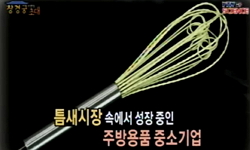Korea initiated its industrial policy in the 1960s. The main focus of Korean industrial policy in the late 1970s shifted from light industry toward the heavy and chemical sector. This sector needed the integration of the supply chain in order to produ...
http://chineseinput.net/에서 pinyin(병음)방식으로 중국어를 변환할 수 있습니다.
변환된 중국어를 복사하여 사용하시면 됩니다.
- 中文 을 입력하시려면 zhongwen을 입력하시고 space를누르시면됩니다.
- 北京 을 입력하시려면 beijing을 입력하시고 space를 누르시면 됩니다.

대기업의 내부거래가 중소기업에 미치는 영향 = Effects of Large Business Group’s Intra-Firm Transaction on Small and Medium-sized Enterprises
한글로보기https://www.riss.kr/link?id=A106986594
- 저자
- 발행기관
- 학술지명
- 권호사항
-
발행연도
2017
-
작성언어
-
- 주제어
-
KDC
300
-
등재정보
KCI등재
-
자료형태
학술저널
-
수록면
49-67(19쪽)
-
KCI 피인용횟수
0
- DOI식별코드
- 제공처
-
0
상세조회 -
0
다운로드
부가정보
다국어 초록 (Multilingual Abstract)
According to Adam Smith, the vertical integration facilitates both division of labor and specialization because the economic unit has a tendency to trade and exchange his own things with others. Also, he addressed that in order to accomplish division of labor and specialization, external transactions by contract are more effective than intra-firm transactions in the group.
However, fair distribution by LEs has not been well implemented. LEs have more benefits than SMEs. Meanwhile, as the global market becomes more competitive, LEs need higher quality parts and materials. For this reason, LEs tend to procure parts and materials through intra-firm transaction in large business group rather than external vertical transaction with SMEs. This purchasing behavior of LEs is to minimize transaction cost and maximize utility, theoretically based on Ronald Coase’s ‘The Nature of the Firm’ which introduces the concept of transaction costs to explain the nature and limits of firms.
Thus, the government entered the market and began to regulate ‘winner takes it all’ and intra-firm transaction. Over the past five years, intra-firm transactions of LEs have declined, not because of government regulations, but because of the decline in turnover of LEs. On the other hand, LEs use intra-firm transactions as a means of expedient corporate succession rather than utility maximization.
Intra-firm transactions in large business group have a negative impact on the business and management environment of SMEs. As results of analyzing the influence of internal transactions of LEs on SMEs, the number of enterprises and employees decreased by 63 and 25,738, respectively when intra-firm transactions of LEs increased by 10%. Meanwhile, the turnover of SMEs increased by about 8 trillion won.
However, the increase on turnover of SMEs reflects the industrial speciality of heavy and chemical industries. If LEs increase intra-firm transactions with their affiliates, LEs have to source the necessary parts from outside. LEs will have to source the necessary parts from outside. Eventually, the increase in intra-firm transactions of LEs leads to the increase in production of SMEs in heavy and chemical industries. But, conversely, SMEs in light industry have severe consequences of reducing turnover and closing down.
The government should now enter the market, seeking to curb intra-firm transactions of LEs and maximize market utility. In this regard, Germany’s ordo liberalism has great implications. According to ordo liberalism, a free market economy can be formed when it is organized and managed by the government. In order to realize this, competition policy is necessary to operate a market function, to create an environment of fair competition, to maintain a balance of society, and to compete for a society dominated by individual responsibility and ethics.
Korea initiated its industrial policy in the 1960s. The main focus of Korean industrial policy in the late 1970s shifted from light industry toward the heavy and chemical sector. This sector needed the integration of the supply chain in order to produce final goods because many parts, components and materials are combined into its products. Generally, small and medium-sized enterprises (SEMs) produce intermediate goods, and then supply those to large enterprises (LEs). LEs, meanwhile, produce final goods, and then export those to the world market. As a result, the increase in exports of LEs leads to an increase in turnover of SMEs which supply intermediate goods to LEs. This virtuous circle has continued for the last forty years. We call this a trickle down effect by the vertical integration between LEs and SMEs.
According to Adam Smith, the vertical integration facilitates both division of labor and specialization because the economic unit has a tendency to trade and exchange his own things with others. Also, he addressed that in order to accomplish division of labor and specialization, external transactions by contract are more effective than intra-firm transactions in the group.
However, fair distribution by LEs has not been well implemented. LEs have more benefits than SMEs. Meanwhile, as the global market becomes more competitive, LEs need higher quality parts and materials. For this reason, LEs tend to procure parts and materials through intra-firm transaction in large business group rather than external vertical transaction with SMEs. This purchasing behavior of LEs is to minimize transaction cost and maximize utility, theoretically based on Ronald Coase’s ‘The Nature of the Firm’ which introduces the concept of transaction costs to explain the nature and limits of firms.
Thus, the government entered the market and began to regulate ‘winner takes it all’ and intra-firm transaction. Over the past five years, intra-firm transactions of LEs have declined, not because of government regulations, but because of the decline in turnover of LEs. On the other hand, LEs use intra-firm transactions as a means of expedient corporate succession rather than utility maximization.
Intra-firm transactions in large business group have a negative impact on the business and management environment of SMEs. As results of analyzing the influence of internal transactions of LEs on SMEs, the number of enterprises and employees decreased by 63 and 25,738, respectively when intra-firm transactions of LEs increased by 10%. Meanwhile, the turnover of SMEs increased by about 8 trillion won.
However, the increase on turnover of SMEs reflects the industrial speciality of heavy and chemical industries. If LEs increase intra-firm transactions with their affiliates, LEs have to source the necessary parts from outside. LEs will have to source the necessary parts from outside. Eventually, the increase in intra-firm transactions of LEs leads to the increase in production of SMEs in heavy and chemical industries. But, conversely, SMEs in light industry have severe consequences of reducing turnover and closing down.
The government should now enter the market, seeking to curb intra-firm transactions of LEs and maximize market utility. In this regard, Germany’s ordo liberalism has great implications. According to ordo liberalism, a free market economy can be formed when it is organized and managed by the government. In order to realize this, competition policy is necessary to operate a market function, to create an environment of fair competition, to maintain a balance of society, and to compete for a society dominated by individual responsibility and ethics.
참고문헌 (Reference)
1 한성안, "진화경제학적 동반성장 모형" 한국경제학회 58 (58): 255-290, 2010
2 오동윤, "제조 중소기업의 혁신을 위한 정책과제 고찰" 한국질서경제학회 18 (18): 135-155, 2015
3 김광수, "애덤 스미스: 식민지 정책과 경제발전" 한국경제학회 59 (59): 143-173, 2011
4 Hwang, I.H, "The Truth of Statistics on Economic Power Concentration" 13 (13): 2013
5 Coase, R. H., "The Nature of the Firm" 6 (6): 386-405, 1937
6 Williamson, O. E., "Organization Theory: From Chester Barnard to the Present and Beyond" Oxford University Press 1995
7 Lundvall, B., "National Systems of Innovation: Toward a Theory of Innovation and Interactive Learning" Anthem Press 2010
8 Cameron, A.C., "Microeconomics: Method and applications" Cambridge University Press 2005
9 Korea Fair Trade Commission, "Intra-firm Transaction in Large Business Group"
10 "Internet Homepage of SME Statistic Database"
1 한성안, "진화경제학적 동반성장 모형" 한국경제학회 58 (58): 255-290, 2010
2 오동윤, "제조 중소기업의 혁신을 위한 정책과제 고찰" 한국질서경제학회 18 (18): 135-155, 2015
3 김광수, "애덤 스미스: 식민지 정책과 경제발전" 한국경제학회 59 (59): 143-173, 2011
4 Hwang, I.H, "The Truth of Statistics on Economic Power Concentration" 13 (13): 2013
5 Coase, R. H., "The Nature of the Firm" 6 (6): 386-405, 1937
6 Williamson, O. E., "Organization Theory: From Chester Barnard to the Present and Beyond" Oxford University Press 1995
7 Lundvall, B., "National Systems of Innovation: Toward a Theory of Innovation and Interactive Learning" Anthem Press 2010
8 Cameron, A.C., "Microeconomics: Method and applications" Cambridge University Press 2005
9 Korea Fair Trade Commission, "Intra-firm Transaction in Large Business Group"
10 "Internet Homepage of SME Statistic Database"
11 Cheon, S.H, "Coase’s Economic Theory and Korean Economy" Research Institute of National Economic Institution 1991
12 Kim, S. J., "An Analysis of the Value-added Production and Distribution of the 50Firms 2002∼13" 2015
13 Oh, D.Y., "A Study of the Legislation of Special Act on Globalization of SMEs" K-Biz 2015
14 Korea Fair Trade Commission, "2016 Status of Business Groups Subject to Limitations on Mutual Investment and Debt Guarantee Restriction"
동일학술지(권/호) 다른 논문
-
한국과 주요국의 조세 및 사회보장 부담에 관한 비교 분석
- 한국질서경제학회
- 국중호 ( Joongho Kook )
- 2017
- KCI등재
-
스위스 산재보험제도 민영화 개혁의 성과 평가와 정책과제
- 한국질서경제학회
- 이정우 ( Jung-woo Lee )
- 2017
- KCI등재
-
- 한국질서경제학회
- 김강식 ( Kang-sik Kim )
- 2017
- KCI등재
-
- 한국질서경제학회
- 김상철 ( Sang-cheol Kim )
- 2017
- KCI등재
분석정보
인용정보 인용지수 설명보기
학술지 이력
| 연월일 | 이력구분 | 이력상세 | 등재구분 |
|---|---|---|---|
| 2022 | 평가예정 | 재인증평가 신청대상 (재인증) | |
| 2019-01-01 | 평가 | 등재학술지 유지 (계속평가) |  |
| 2016-01-01 | 평가 | 등재학술지 유지 (계속평가) |  |
| 2012-01-01 | 평가 | 등재학술지 선정 (등재후보2차) |  |
| 2011-01-01 | 평가 | 등재후보 1차 PASS (등재후보1차) |  |
| 2010-01-01 | 평가 | 등재후보학술지 유지 (등재후보2차) |  |
| 2009-01-01 | 평가 | 등재후보 1차 PASS (등재후보1차) |  |
| 2007-01-01 | 평가 | 등재후보학술지 선정 (신규평가) |  |
학술지 인용정보
| 기준연도 | WOS-KCI 통합IF(2년) | KCIF(2년) | KCIF(3년) |
|---|---|---|---|
| 2016 | 0.46 | 0.46 | 0.43 |
| KCIF(4년) | KCIF(5년) | 중심성지수(3년) | 즉시성지수 |
| 0.42 | 0.4 | 0.668 | 0.24 |




 KCI
KCI KISS
KISS





